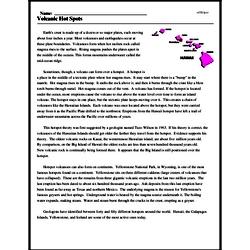Volcanic Hot Spots
Earth's crust is made up of a dozen or so major plates, each moving about four inches a year. Most volcanoes and earthquakes occur at these plate boundaries. Volcanoes form when hot molten rock called magma rises to the surface. Rising magma pushes the plates apart in the middle of the oceans. This forms mountains underwater called the mid-ocean ridge.
Sometimes, though, a volcano can form over a hotspot. A hotspot is a place in the middle of a tectonic plate where hot magma rises. It may start where there is a "bump" in the mantle. Hot magma rises in the bump. It melts the rock above it, and then it burns through the crust like a blow torch burns through metal. Hot magma comes out of the vent. A volcano has formed. If the hotspot is located under the ocean, more eruptions cause the volcano to rise above the water level over time to form an island volcano. The hotspot stays in one place, but the tectonic plate keeps moving over it. This creates a chain of volcanoes like the Hawaiian Islands. Each volcano was once located above the hotspot, but they were carried away from it as the Pacific Plate drifted to the northwest. Eruptions from the Hawaii hotspot have left a trail of underwater mountains across the Pacific over millions of years.
This hotspot theory was first suggested by a geologist named Tuzo Wilson in 1963. If his theory is correct, the volcanoes of the Hawaiian Islands should get older the farther they travel from the hotspot. Evidence supports his theory. The oldest volcanic rocks on Kauai, the westernmost Hawaiian island, are about five million years old. By comparison, on the Big Island of Hawaii the oldest rocks are less than seven hundred thousand years old. New volcanic rock is continually being formed there. It appears that the Big Island is still positioned over the hotspot.




